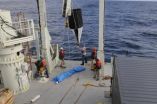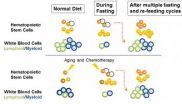(Press-News.org) SAN ANTONIO, Texas (June 5, 2014) — Scientists this week reported that a molecular pathway called mTORC1 controls the conversion of unhealthy white fat into beige fat, an appealing target for increasing energy expenditure and reducing obesity. The team, led by researchers from the School of Medicine at The University of Texas Health Science Center at San Antonio, also found that a protein, Grb10, serves as the on-off switch for mTORC1 signaling and the "beigeing" of fat.
The finding could inform development of novel diabetes and obesity drugs, the scientists said. The study is reported in this month's issue of Cell Metabolism and was selected as the highlighted featured article.
Heat in response to cold
Grb10 is stimulated by cold stress, which causes the body to burn energy. ""We know that if we want to keep our body lean, we have to get rid of extra nutrients in the body, which means burning more energy," said senior author Feng Liu, Ph.D., professor of pharmacology at the UT Health Science Center and director of the Metabolic Syndrome Research Center at Xiangya Second Hospital, Central South University, in Changsha, China.
"Understanding how beigeing is controlled is so very important because if we can improve energy expenditure, we can reduce obesity," Dr. Liu said.
Undesirable storage
Adipose (fat) tissues, which include white adipose tissue and brown adipose tissue, are important regulators of metabolism. Having too much white adipose tissue and not burning it off through exercise or other energy expenditure is associated with obesity and metabolic diseases such as type 2 diabetes.
"Normally when we eat something, we store it in white fat," said co-author Lily Dong, Ph.D., professor of cellular and structural biology at the UT Health Science Center. "For the extra food we eat, it is better to release it, not store it. So finding a way to turn the white fat into beige and burn the energy that normally we store would have high therapeutic potential for the treatment of obesity and its related diseases. Dr. Liu has identified the pathway to do this."
Broader application
The mTORC1 pathway is also involved in aging, cardiovascular disease and cancer, so identifying the regulator of this pathway, Grb10, should be very informative for researching other fields, Dr. Liu said.
Drs. Liu and Dong also are members of the Health Science Center's Barshop Institute for Longevity and Aging Studies.
INFORMATION:
Cell Metabolism
Volume 19, Issue 6, 3 June 2014, Pages 967-980
Grb10 Promotes Lipolysis and Thermogenesis by Phosphorylation-Dependent Feedback Inhibition of mTORC1
Meilian Liu,1,2,7 Juli Bai,1,2 Sijia He,1,2 Ricardo Villarreal,3 Derong Hu,1 Chuntao Zhang,1,4 Xin Yang,3 Huiyun Liang,3 Thomas J. Slaga,1 Yonghao Yu,5 Zhiguang Zhou,2 John Blenis,5 Philipp E. Scherer,6 Lily Q. Dong,3 and Feng Liu1,2
1 Department of Pharmacology, University of Texas Health Science Center at San Antonio, 7703 Floyd Curl Drive, San Antonio, TX 78229, USA
2 Metabolic Syndrome Research Center and Diabetes Center, Key Laboratory of Diabetes Immunology, Ministry of Education, Second Xiangya Hospital, Central South University, 139 Middle Renmin Road, Changsha, Hunan 410011, China
3 Department of Cellular and Structural Biology, University of Texas Health Science Center at San Antonio, 7703 Floyd Curl Drive, San Antonio, TX 78229, USA
4 The Department of Microbiology, School of Basic Medicine, Xinjiang Medical University, 393 Xinyi Road, Urumqi, Xinjiang 830011, China
5 Department of Cell Biology, Harvard Medical School, 240 Longwood Avenue, Boston, MA 02115, USA
6 Touchstone Diabetes Center, Department of Internal Medicine, and Department of Cell Biology, UT Southwestern Medical Center, 5323 Harry Hines Boulevard, Dallas, TX 75390-8549, USA
7 Present address: Department of Biochemistry and Molecular Biology, University of New Mexico Health Science Center, 915 Camino de Salud NE, Albuquerque, NM 87131, USA
This work was supported by National Institutes of Health RO1 grant DK100697 and grants from the National Nature Science Foundation of China (81130015) and the National Basic Research Program of China (2014CB910500) to Feng Liu; an American Diabetes Association Junior Faculty Award (1-13-JF-37) and an American Heart Association Beginning in Aid Award (11BGIA7620074) to Meilian Liu; NIH RO1 grants DK69930 to Lily Dong, GM51405 to Juli Bai, and DK55758, DK099110, and P01-DK088761 to Philipp Scherer; an American Cancer Research Center & Foundation grant to Huiyun Liang; and a grant to Thomas Slaga from the Cancer Therapy & Research Center at the UT Health Science Center at San Antonio P30 grant.
On the Web and social media
For current news from the UT Health Science Center San Antonio, please visit our news release website, like us on Facebook or follow us on Twitter.
About the UT Health Science Center at San Antonio
The University of Texas Health Science Center at San Antonio, one of the country's leading health sciences universities, ranks in the top 3 percent of all institutions worldwide receiving National Institutes of Health funding. The university's schools of medicine, nursing, dentistry, health professions and graduate biomedical sciences have produced more than 29,000 graduates. The $765 million operating budget supports eight campuses in San Antonio, Laredo, Harlingen and Edinburg. For more information on the many ways "We make lives better®," visit http://www.uthscsa.edu.
Team finds on-off switch to burning stored fat
2014-06-05
ELSE PRESS RELEASES FROM THIS DATE:
How do phytoplankton survive a scarcity of a critical nutrient?
2014-06-05
Phytoplankton—tiny, photosynthetic organisms—are essential to life on Earth, supplying us with roughly half the oxygen we breathe. Like all other life forms, phytoplankton require the element phosphorus to carry out critical cellular activity, but in some parts of the world's ocean, P is in limited supply. How do phytoplankton survive when phosphorus is difficult to find?
Phytoplankton can alter their biochemical make-up according to the availability of nutrients in the water. When phosphorus (P) is particularly abundant in the water, phytoplankton produce and store ...
Stimulating a protein in skin cells could improve psoriasis symptoms
2014-06-05
Psoriasis is a common, long-lasting disease that causes itchy or sore patches of thick, red skin with silvery scales. Environmental contaminants can trigger psoriasis and other autoimmune disorders, and it is thought that a protein called the aryl hydrocarbon receptor (AhR), which senses environmental toxins, could play a role. A study published by Cell Press on June 5 in the journal Immunity shows that the severity of inflammation associated with psoriasis is unexpectedly suppressed by AhR. The findings suggest that stimulation of AhR could improve symptoms and may represent ...
Neurons transplanted into Parkinson's-affected brains appear healthy after 14 years
2014-06-05
When transplanted into the midbrains of adult patients with Parkinson's disease, dopamine neurons derived from fetal tissue can remain healthy for many years. The findings reported in the Cell Press journal Cell Reports on June 5th suggest that transplanted neurons don't degenerate over time as some had suggested and feared they would, which provides further rationale for pursuing stem cells as a source for transplant-ready dopamine neurons, according to the researchers.
"Our findings show a robust expression of dopamine transporters and a lack of abnormal mitochondrial ...
Activating the immune system could treat obesity and diabetes
2014-06-05
Obesity is a worldwide epidemic that is causing alarming rates of diabetes and cardiovascular disease, but currently there is a lack of effective drug treatments. Two unrelated studies published by Cell Press June 5th in the journal Cell reveal an important role for immune pathways in activating good types body fat, called brown and beige fat, which burn stored calories, reduce weight, and improve metabolic health. The findings could pave the way for much-needed treatments for obesity and related metabolic diseases.
"The idea that metabolic health can be improved by activation ...
Fasting may help protect against immune-related effects of chemotherapy and aging
2014-06-05
While chemotherapy can save lives, it can also cause many side effects, including the depletion of immune cells. Also, even in the absence of chemotherapy, normal aging takes a heavy toll on the immune system, leading to immune deficiencies and a higher risk of developing leukemia and a variety of malignancies with age. Now researchers reporting in the June 5th issue of the Cell Press journal Cell Stem Cell have found that a simple dietary intervention—periodic fasting—may combat both chemotherapy-induced and aging-related changes in immune cell function by replenishing ...
Outcomes of a 2-year national rare disease gene discovery project
2014-06-05
OTTAWA, ON – June 5, 2014 – As part of the Finding of Rare Disease Genes (FORGE) research project, Canadian researchers have developed an expertise in understanding the underlying biology of rare childhood disorders. The first public commentary of this nationwide study is available today in the American Journal of Human Genetics.
"When we launched this project, we predicted we might explain, or solve, 50 disorders; we've almost tripled that goal," said Dr. Kym Boycott, lead investigator of FORGE and clinician scientist at the Children's Hospital of Eastern Ontario ...
First 3-D pterosaur eggs found with their parents
2014-06-05
Researchers have discovered the first three-dimensionally preserved pterosaur eggs in China. The eggs were found among dozens, if not hundreds, of pterosaur fossils, representing a new genus and species (Hamipterus tianshanensis). The discovery, described in the Cell Press journal Current Biology on June 5, reveals that the pterosaurs—flying reptiles with wingspans ranging from 25 cm to 12 m—lived together in gregarious colonies.
Xiaolin Wang of the Chinese Academy of Sciences' Institute of Vertebrate Paleontology and Paleoanthropology says it was most exciting to find ...
McLean Hospital researchers see promise in transplanted fetal stem cells for Parkinson's
2014-06-05
BELMONT, MA -- Researchers at Harvard-affiliated McLean Hospital have found that fetal dopamine cells transplanted into the brains of patients with Parkinson's disease were able to remain healthy and functional for up to 14 years, a finding that could lead to new and better therapies for the illness.
The discovery, reported in the June 5, 2014 issue of the journal Cell Reports, could pave the way for researchers to begin transplanting dopamine neurons taken from stem cells grown in laboratories, a way to get treatments to many more patients in an easier fashion.
"We ...
Fasting triggers stem cell regeneration of damaged, old immune system
2014-06-05
In the first evidence of a natural intervention triggering stem cell-based regeneration of an organ or system, a study in the June 5 issue of the Cell Press journal Cell Stem Cell shows that cycles of prolonged fasting not only protect against immune system damage — a major side effect of chemotherapy — but also induce immune system regeneration, shifting stem cells from a dormant state to a state of self-renewal.
In both mice and a Phase 1 human clinical trial, long periods of not eating significantly lowered white blood cell counts. In mice, fasting cycles then "flipped ...
Immune system molecules may promote weight loss, UCSF study finds
2014-06-05
The calorie-burning triggered by cold temperatures can be achieved biochemically – without the chill – raising hopes for a weight-loss strategy focused on the immune system rather than the brain, according to a new study by UC San Francisco researchers.
The team determined that two signaling molecules secreted by cells of the immune system trigger the conversion of fat-storing white fat cells to fat-burning beige fat cells. Ajay Chawla, MD, PhD, an associate professor of medicine at the UCSF Cardiovascular Research Institute, led the study, published online June 5, 2014 ...



